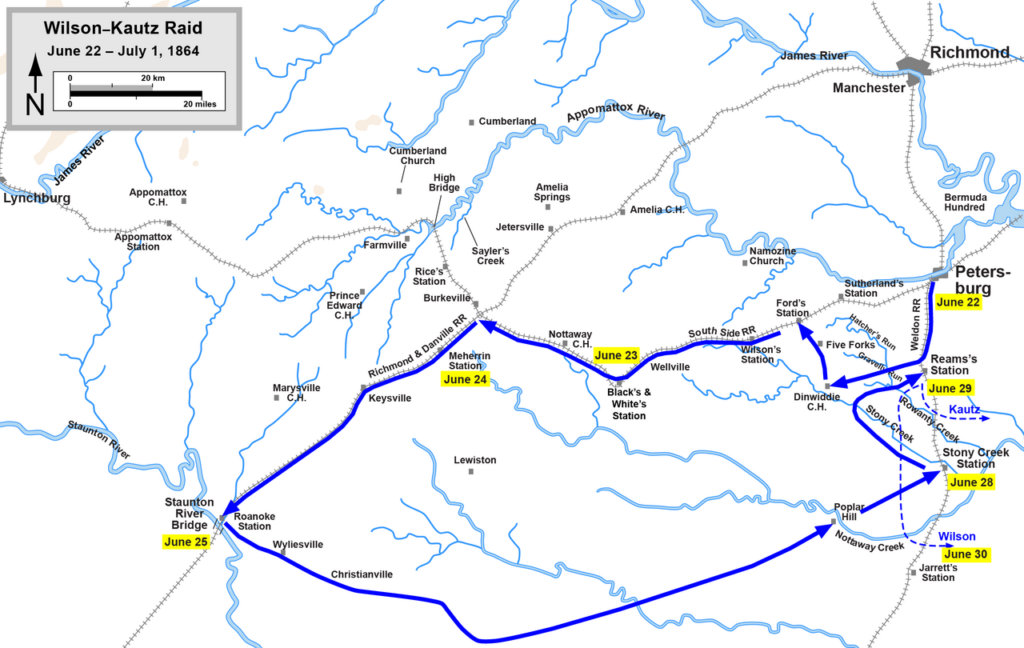Maps:
Download PDF Official Virginia Civil War Trails map.
Driving Tour
Here are the sites associated with the June 1864 Wilson-Kautz Raid Trail. Each is interpreted with a Virginia Civil War Trails sign.

Prince George Court House – U.S. Gens. Wilson & Kautz departed nearby for their 300-mile cavalry raid to destroy railroads in Southside Virginia.
Reams Station – Station burned by Wilson-Kautz raiders on June 22, 1864. During the expedition’s return to Petersburg on June 28, a 10-hour skirmish ensued nearby between the Federal raiders and Confederate Gen. William. Mahone’s forces.
Dinwiddie Court House – Before turning north to the South Side Railroad, the Wilson-Kautz raiders destroyed local records and appropriated local livestock.
Five Forks – The raiders passed here on their initial movement toward the South Side Railroad. Here, Gen. Wilson learned of the Confederate attack on his rear guard at Dinwiddie Court House.
Ford’s Depot – The Wilson-Kautz raiders reached this point at sundown on June 22 and destroyed two trains and military supplies.
Black’s & White’s Station – A local resident gave Wilson incorrect directions, which allowed Confederate forces to temporarily block the Federal advance.
Battle of Nottoway – First sizable engagement fought on the Wilson-Kautz Raid.
St. Mark’s Store – Parties of Union foragers roamed in search of food and horses, meeting sporadic resistance.
Burkeville Junction – This junction of the South Side Railroad and Richmond & Danville Railroad was a key objective of the Wilson-Kautz Raid.
Meherrin Station – Wilson, entrenched at Nottoway Court House, received word of Kautz’s success in destroying Burkeville Junction. Both Union columns rejoined here.
Keysville – The combined Wilson-Kautz column reached here by nightfall of June 24.
Charlotte Court House – After destroying railroad facilities at Burkeville Junction, Meherrin Station and Keysville, fears of local citizens were eased when the detachment burned no buildings.
Drake’s Branch – The Union force halted here for two hours on June 25 and continued destroying track.
Carrington’s Mill – Rufus Barringer’s North Carolina Brigade attacked the Federal rear guard on the hill north of here.
Mulberry Hill – Union headquarters during the Battle of Staunton River Bridge. Roanoke Station – The railroad track was destroyed from Drake’s Branch to here just prior to the Battle of Staunton River Bridge.
Staunton River Battlefield State Park – Confederate earthworks remain from the June 25, 1864, battle.
Wylliesburgh – Site of the expedition’s first pause following the Battle of Staunton River Bridge. From this point on, the Federal raiders were in a race to safety.
Christiansville – Fatigued and disorganized following the route at Staunton River Bridge, parties of Federals took farm animals and personal property from area homes.
Mount Horeb Church – Skirmish site where Confederate Gen. Rufus Barringer’s North Carolina Brigade struck the rear of the Federal column.
St. John’s Church – Communion set from the church was stolen by the raiders and recovered days later at Reams Station.
Danieltown – Seven local men captured 32 of Wilson’s cavalrymen near here. Smoky Ordinary – Wilson’s raiders camped here on their retreat to the Union lines at Petersburg following their repulse at Staunton River Bridge.
Double Bridges – Wilson made a fateful decision here to proceed north toward Reams Station.
Sappony Church – Skirmish site where Wilson attempted to force his way through to Reams Station just as C.S. Gen. Wade Hampton’s cavalry appeared.
Stony Creek Bridge – Following the skirmish at Sappony Church, the shattered remains of Wilson’s command make a brief stand here.
Halifax – Men and boys from Halifax mustered here prior to the Battle of Staunton River Bridge.
Prince George Court House – Following the skirmish at Sappony Church, the shattered remains of Wilson’s command make a brief stand here.
Halifax – Men and boys from Halifax mustered here prior to the Battle of Staunton River Bridge.

